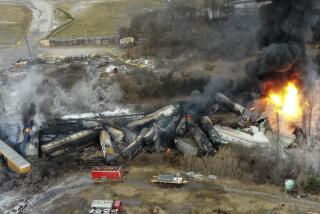Engineer’s split shift is probed
- Share via
Federal investigators are trying to determine whether back-to-back, split-shift workdays that began before dawn and ended at 9 p.m. played a role in a Metrolink engineer’s failure to heed warning lights in last week’s crash that left 25 people dead.
Engineer Robert M. Sanchez’s regular five-day workweek was spread over nearly 53 hours, according to authorities. He would have been near the end of that schedule Friday afternoon when his train sped through a red light and collided head-on with a Union Pacific freight train.
National Transportation Safety Board member Kitty Higgins told The Times that she was “very concerned” about Sanchez’s schedule, saying a “human performance team” will pursue evidence that might shed light on the possible effects of Sanchez’s shift.
“It’s a long day,” she said.
Typically, Sanchez worked five days of identical shifts: He began his day just before 6 a.m., worked until almost 9:30 a.m. and took a 4 1/2 -hour break before beginning a seven-hour shift at 2 p.m., according to the NTSB. The crash occurred Friday at 4:23 p.m.
The conductor on Sanchez’s train told federal investigators Tuesday that Sanchez took a two-hour nap during his break Friday, Higgins told reporters. The conductor, who had been working with Sanchez since April, said he had no problems with the way the engineer operated the train.
Fatigue caused by the irregular and often long work schedules of train crews has been a persistent and deadly problem in the railroad industry despite decades of study. Safety regulators have called for measures that would require railroads to provide longer rest periods between shifts.
The NTSB has warned that operating a train or other vehicles without sufficient rest “presents an unnecessary risk to the traveling public” and lists reforms to address fatigue as one of its “most wanted” rail safety improvements.
However, Metrolink’s top executive told Congress last year that proposals to increase minimum off-duty time for rail workers were unnecessary for commuter systems. David R. Solow told a Senate subcommittee that commuter rail had a good safety record and that existing practices provided adequate assurance “that fatigue does not affect safety,” records show.
Commuter train workers often work split shifts because of morning and evening peak passenger loads, Solow said. He argued that unlike long-distance freight workers, commuter line workers often have interim rest hours of at least four hours and also are able to return to their homes each night.
Additional limits on work time would probably force commuter rail systems to hire more crews, driving up costs that would be passed on to riders and taxpayers, he said. The fare hikes, he added, would “drive riders back to commuting by automobile,” undermining efforts to conserve energy and reduce air pollution and traffic congestion.
Solow called for more study of fatigue as it relates to commuter rail systems before new work schedule restrictions were imposed.
His comments last July were made during the same appearance before Congress in which he asked that systems such as Metrolink be given flexibility in choosing the technology they employ to avoid collisions, at a time when federal regulators and some lawmakers were pushing to mandate automated train-stopping devices.
A Metrolink spokesman said the agency could not comment on engineer work schedules. Solow did not respond to a request for comment.
Last year’s proposed changes were not approved, but Congress is again considering a similar bill that would increase the minimum time an engineer must be off duty before a new shift from eight to 10 hours.
That type of change apparently would have required an adjustment to Sanchez’s schedule, to give him more time off overnight.
Tired crews have caused some of the deadliest and costliest freight train wrecks of the last 20 years, according to federal accident reports.
NTSB records show that entire crews have nodded off at the controls of mile-long freight trains, including some carrying hazardous materials.
But federal studies show that passenger train crews face challenges in getting adequate rest even if they work more predictable schedules near their homes.
Split shifts in particular can result in long days that leave little time for adequate rest, according to research by the Volpe National Transportation System Center in Massachusetts.
A head-on collision of two New Jersey Transit commuter trains in February 1996 that killed three people and injured 162 was partly attributed to a nighttime split shift worked by one of the engineers.
A University of Connecticut study in May 2003 found that transit workers who had split shifts reported less sleep per day and more mental exhaustion than transit workers who worked conventional shifts.
Engineers, brake operators and conductors have likened on-the-job fatigue to being in a constant state of jet lag.
And some researchers say current law simply does not allow enough time for commutes, family obligations, meals and getting ready for work, they say.
“It doesn’t make scientific or physiological sense,” said Mark R. Rosekind, a past director of NASA’s fatigue countermeasures program and a former consultant to Union Pacific. “It calls for a minimum of eight hours off, but people need eight hours of sleep a day on average.”
Tim Smith, an official for the Brotherhood of Locomotive Engineers and Trainmen, said the only “saving grace” for passenger engineers is their set work schedules.
But that does not address the problem of cumulative fatigue due to long hours, he said.
Smith said split shifts make it difficult for a crew member to get eight hours of continuous sleep before reporting to work again, except on weekends off.
--
rich.connell@latimes
robert.lopez@latimes.com
More to Read
Sign up for Essential California
The most important California stories and recommendations in your inbox every morning.
You may occasionally receive promotional content from the Los Angeles Times.















